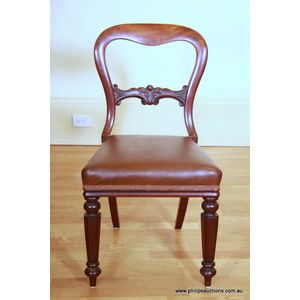Victorian Rosewood Dining Chairs with Carved Details
You must be a subscriber, and be logged in to view price and dealer details.
Subscribe Now to view actual auction price for this item
When you subscribe, you have the option of setting the currency in which to display prices to $Au, $US, $NZ or Stg.
- Victorian Period - The Victorian period of furniture and decorative arts design covers the reign of Queen Victoria from 1837 to 1901. There was not one dominant style of furniture in the Victorian period. Designers used and modified many historical styles such as Gothic, Tudor, Elizabethan, English Rococo, Neoclassical and others, although use of some styles, such as English Rococo and Gothic tended to dominate the furniture manufacture of the period.
The Victorian period was preceded by the Regency and William IV periods, and followed by the Edwardian period, named for Edward VII (1841 ? 1910) who was King of the United Kingdom and the British Dominions and Emperor of India for the brief period from 1901 until his death in 1910. - Rosewood - A dense timber that varies in shade to very light brown to almost black. When rosewood is cut and sanded the colour of the timber will turn black, and after polishing and exposure to daylight, the surface will gradually lighten over time to light brown with black streaks.
The name comes from the odour emanating from the timber when it is planed, sanded or cut.
Rosewood was very popular for use in Victorian furniture in the second half of the 19th century, and at that time most of the rosewood was imported from Brazil. However it also grows in India and Indonesia.
It is used in the sold for chairs and table legs, but for carcase furniture such as side cabinets and bookcases, and for table tops it is always used as a veneer. - Turned Legs - are legs which have been turned on a lathe. In use from the 16th century, turned legs on tables, chairs and cabinets became more frequent until, by the 1830s, the Georgian square or tapered leg was rarely found except in country pieces.
- Skirt - In furniture, the skirt is a strip of wood underneath the top or front of the item. On chairs, the skirt is the support under the seat joining the legs, while on tables, the skirt is the support under the top, that assists in supporting the top and also joins the legs. On carcase furniture such as chests and cabinets, the skirt is the timber strip immediately under the drawers or cupboard.
- Turning - Any part of a piece of furniture that has been turned and shaped with chisels on a lathe. Turned sections include legs, columns, feet, finials, pedestals, stretchers, spindles etc. There have been many varieties and fashions over the centuries: baluster, melon, barley-sugar, bobbin, cotton-reel, rope-twist, and so on. Split turning implies a turned section that has been cut in half lengthwise and applied to a cabinet front as a false decorative support.
This item has been included into following indexes:
-
chairs, sets of 4, style or period
- all styles 501
- Hepplewhite style 72
- Victorian 138
- chairs, sets of 4, timber - rosewood 24
Visually similar items

A set of four Victorian mahogany balloon back chairs, 19th century, the waisted chairs with a foliate carved mid rail above a square stuffover seat, upholstered in deep maroon/brown leatherette and raised upon knopped and fluted baluster legs and toupie fe

A Victorian mahogany dining chair, the spade-back with carved cross-rail above the stuff-over seat, on turned front supports. Height 87 cm. Width 49 cm. Depth 54 cm

A set of eight Victorian mahogany balloon back chairs, second half 19th century, the chairs of waisted form having scrolling and acanthus carved mid rails to generous stuffover seats of shaped profile and supported on slender and tapering ribbed legs and t

A set of six Victorian mahogany balloon back chairs, circa 1880s, with rounded cresting rails with scroll embellishments and a foliate mid rail, with stuff over seats and upon baluster shaped turned legs, upholstered in sage velvet. Height 89 cm
